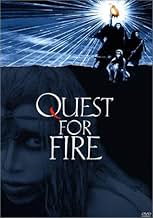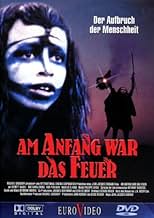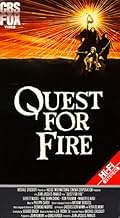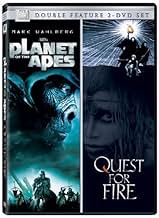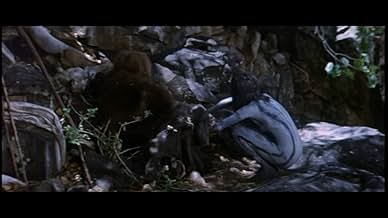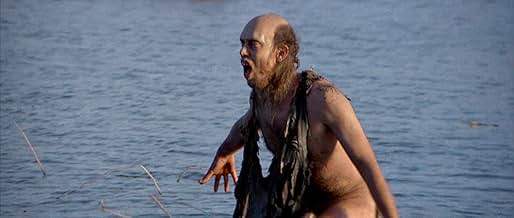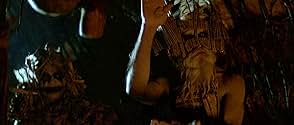This story takes place in prehistoric time when three tribesmen search for a new fire source.This story takes place in prehistoric time when three tribesmen search for a new fire source.This story takes place in prehistoric time when three tribesmen search for a new fire source.
- Won 1 Oscar
- 11 wins & 8 nominations total
Nicholas Kadi
- Gaw
- (as Nameer El-Kadi)
Franck-Olivier Bonnet
- Aghoo - The Ulam Tribe
- (as Frank Olivier Bonnet)
Joy Boushel
- The Ulam Tribe
- (as Joy Boushell)
- Director
- Writers
- All cast & crew
- Production, box office & more at IMDbPro
Featured review
Stanley Kubrick's classic "2001" celebrates the first weapon, when a hairy primate through some burst of savage genius turns a useless thigh-bone into a dominating club. He thereby takes a giant first step in humanity's long pursuit of bigger and better weapons. On the other hand, "Quest for Fire" dramatizes humanity's other side: the civilizing arrival of the campfire. But not just any campfire; instead it's the security found in mastering the technique to make fire any time the tribe wants. As a result, the Cro-Magnons have for the first time some control over their environment and can take time to relax. That's made apparent at film's end when the clan gathers happily around crackling embers to relate stories through crude gestures and grunts. Perhaps the evolution of complex linguistic forms had its origins in just such relaxed moments, when imagination and thinking could take hold and get expression in the company of others.
There's also that overlooked moment when Naoh humbly approaches the lordly herd of marauding mastodons. Tufts of grass in hand, he bows his head in an unmistakable gesture of submission, to which the herd responds-- not very plausibly --by chasing away the attacking cannibal clan. The point here is that Naoh understands in that quiet moment that we must live humbly with those forces much greater than ourselves if we want to survive-- a possible seed of what would later become religious belief, whether in the forces of nature or in the supposed power of the supernatural.
Of course, this is all speculation. The filmmakers don't exactly hit you over the head with their messages. However, the point is that the film succeeds admirably in getting you to think about the natural history of what these lowly but momentous origins must have been like. Moreover, there are other suggestive moments, such as when the camera transitions from Rae Dawn Chong's pregnant belly to the distant full moon and humanity's far-off future. Some reviewers point out scientific flaws in the script and reject the film on that basis. But that misses the point. Of course the film is not a documentary, so no serious researcher would base a study on it. Nonetheless, the movie remains just that, a well-staged and provocative ninety minutes of unusual filmmaking. I've seen nothing like it before or since.
There's also that overlooked moment when Naoh humbly approaches the lordly herd of marauding mastodons. Tufts of grass in hand, he bows his head in an unmistakable gesture of submission, to which the herd responds-- not very plausibly --by chasing away the attacking cannibal clan. The point here is that Naoh understands in that quiet moment that we must live humbly with those forces much greater than ourselves if we want to survive-- a possible seed of what would later become religious belief, whether in the forces of nature or in the supposed power of the supernatural.
Of course, this is all speculation. The filmmakers don't exactly hit you over the head with their messages. However, the point is that the film succeeds admirably in getting you to think about the natural history of what these lowly but momentous origins must have been like. Moreover, there are other suggestive moments, such as when the camera transitions from Rae Dawn Chong's pregnant belly to the distant full moon and humanity's far-off future. Some reviewers point out scientific flaws in the script and reject the film on that basis. But that misses the point. Of course the film is not a documentary, so no serious researcher would base a study on it. Nonetheless, the movie remains just that, a well-staged and provocative ninety minutes of unusual filmmaking. I've seen nothing like it before or since.
- dougdoepke
- Mar 31, 2014
- Permalink
Storyline
Did you know
- TriviaBoth Ron Perlman and Everett McGill suffered frostbite; luckily they were able to heal completely. Despite the working conditions, they both enjoyed making the film.
- GoofsThe movie is set 80,000 years ago, and appears to show the one tribe has made pottery. Fragments of ancient pottery found in southern China date back to only 20,000 years, making them the world's oldest known pottery. However, the vessel shown is actually a dried hollow gourd.
- Quotes
[first lines]
Title Card: 80,000 years ago, man's survival in a vast uncharted land depended on the possession of fire. / For those early humans, fire was an object of great mystery, since no one had mastered its creation. Fire had to be stolen from nature, it had to be kept alive - sheltered from wind and rain, guarded from rival tribes. / Fire was a symbol of power and a means of survival. The tribe who possessed fire, possessed life.
- Alternate versionsAll UK versions are cut by 8 secs and are missing a shot of a wolf on fire.
- ConnectionsFeatured in À propos de 'La guerre du feu' (1981)
- How long is Quest for Fire?Powered by Alexa
Details
- Release date
- Countries of origin
- Languages
- Also known as
- Quest for Fire
- Filming locations
- Production companies
- See more company credits at IMDbPro
Box office
- Budget
- $12,500,000 (estimated)
- Gross US & Canada
- $20,959,585
- Gross worldwide
- $20,962,615
- Runtime1 hour 40 minutes
- Color
- Aspect ratio
- 2.35 : 1
Contribute to this page
Suggest an edit or add missing content













![Bande-annonce [OV]](https://m.media-amazon.com/images/M/MV5BZTg3YWU0MTMtMDk1Mi00M2Y4LWFiODgtYzFhOTAyMWRjYWY2XkEyXkFqcGdeQXRyYW5zY29kZS13b3JrZmxvdw@@._V1_QL75_UY281_CR74)

